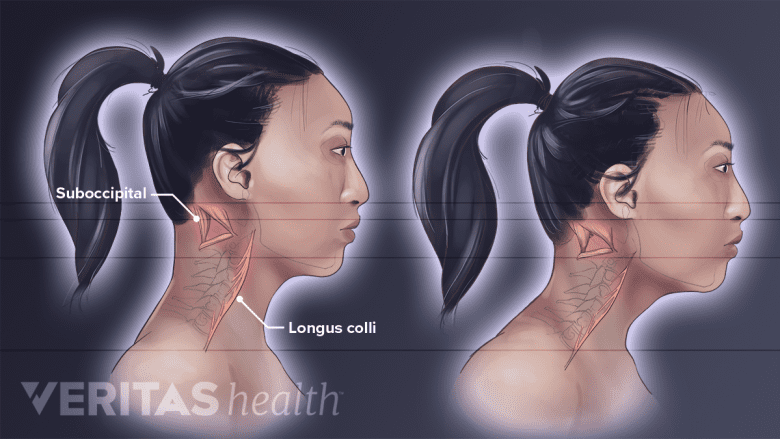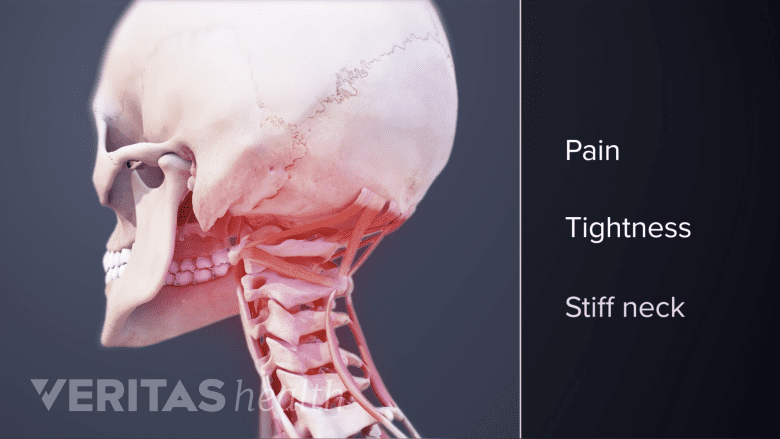Forward head posture increases the workload for many of the muscles attached to the cervical spine, which has the job of holding up the head. Over time, forward head posture can lead to muscle imbalances as the body tries to adapt and find efficient ways to hold the head up for straight-ahead vision. Some muscles become elongated and weakened, whereas other muscles become shorter and tighter.
In This Article:
- How Poor Posture Causes Neck Pain
- Forward Head Posture’s Effect on Neck Muscles
- Forward Head Posture’s Effect on the Cervical Spine
- How to Measure and Fix Forward Head Posture
- Workplace Ergonomics and Neck Pain
Muscles That Become Long and Weakened

Forward head posture can lead to an imbalance in the longus colli and suboccipital muscles.
Common muscles that elongate and weaken due to long-term forward head posture include:
- Deep cervical flexors. These muscles, also called the longus capitus and longus colli, are located along the front of the cervical spine and help stabilize the neck. When weakened, the deep cervical flexors lengthen as the chin tilts away from the neck, often called “chin poking.”
- Erector spinae (lower cervical and upper thoracic).These are extensor muscles attached to the back of the lower cervical spine and upper thoracic spine. The erector spinae play a key role in rotating and straightening the spine. When the erector spinae muscles lengthen and lose strength, they are less capable of keeping the neck and upper back from hunching forward.
- Shoulder blade retractors. The middle trapezius and rhomboid muscles in the upper back help bring the scapulae (shoulder blades) backward to keep the shoulders back and chest open in good posture. Weakened trapezius and rhomboid muscles allow the shoulder blades to tilt forward, further contributing to hunched shoulders and forward head posture.
See Neck Muscles and Other Soft Tissues
When trying to correct forward head posture and relieve neck pain, these are muscles that may need to be targeted for strengthening. Also, other muscles may also need to be strengthened to help reduce forward head and rounded shoulder posture, depending on the patient’s specific needs.
Muscles That Become Short and Tightened

Over time, incorrect posture can cause chronic pain in the neck and surrounding muscles.
These are the muscles that commonly shorten and tighten due to long-term forward head posture:
- Suboccipital muscles. These 4 pairs of small muscles, which connect the lower back of the skull to the top of the cervical spine, help with head rotation and extension. These muscles work extra hard and continually contract to keep the head tilted up and looking straight ahead during forward head posture.
- Chest muscles. As the muscles in the upper back tend to become elongated as the shoulder round forward, chest muscles may become shortened and tight. An example includes the pectoralis minor muscles, which are a pair of thin triangular muscles in the upper part of the chest.
- Levator scapulae muscles. This pair of muscles is located along the back and side of the neck, traveling from the upper cervical spine down to the shoulder blade (scapula). The levator scapulae plays a key role in lifting or elevating the scapula, in addition to helping with various neck movements. If the shoulder blade starts to tilt forward and rotate up with rounded shoulders, the levator scapulae muscles may become shortened.
These muscles are commonly the focus of stretches to help reduce neck pain and improve forward head posture. Numerous other muscles may become shortened or lengthened due to forward head posture, and the specific muscle imbalances can vary depending on the case.
Forward Head Posture and Muscle Pain Symptoms

Forward head posture can lead to muscle, joint, disc, and nerve root-related pain.
When forward head posture causes muscle pain, it typically feels like one or more of the following:
- General soreness. This dull or achy pain may spread across the side or back of the neck, as well as into the upper back, shoulder, and/or head.
- Intense pain. If a muscle is strained and/or goes into spasm, resulting in tightness and severe pain that may feel sharp or burning. Intense neck pain may worsen with specific positions or movements but alleviate in other positions or at rest. This pain is typically localized in one spot—such as the side of the neck or base of the skull—rather than spreading across a region.
- Trigger point pain. This pain involves tender, taut spots in muscles that can become even more painful when touched. Trigger points are especially common along the back of the neck, but the pain can also be referred up into the head or down into the shoulders. Some studies have linked trigger point pain as being more likely with forward head posture, especially in people who have migraines or other types of headaches.1Fernandez-de-las-Penas C, Cuadrado ML, Pareja JA. Myofascial trigger points, neck mobility and forward head posture in unilateral migraine. Cephalalgia. 2006; 26(9):1061-70.,2Fernandez-de-las-Penas C, Alonsl-Blanco C, Cuadrado ML, Gerwin RD, Pareja JA. Trigger points in the suboccipital muscles and forward head posture in tension-type headache. Headache. 2006;46(3):454-60.
- Muscle tightness. Muscles can become inflamed and tight due to being overworked, injury, trigger point pain, or in response to nearby inflammation, such as from a herniated disc. Due to pain and reduced muscle function, the neck may become stiff or less mobile.
Forward head posture can lead to more than just muscle pain, including pain that stems from the joints, discs, nerve roots, and other nearby structures.
- 1 Fernandez-de-las-Penas C, Cuadrado ML, Pareja JA. Myofascial trigger points, neck mobility and forward head posture in unilateral migraine. Cephalalgia. 2006; 26(9):1061-70.
- 2 Fernandez-de-las-Penas C, Alonsl-Blanco C, Cuadrado ML, Gerwin RD, Pareja JA. Trigger points in the suboccipital muscles and forward head posture in tension-type headache. Headache. 2006;46(3):454-60.

